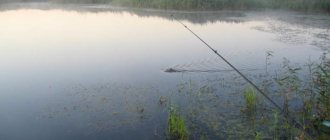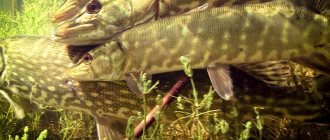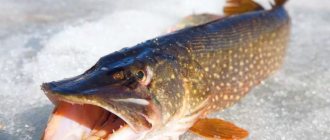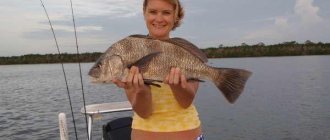Pike is an ancient predator, common in Europe, Asia, and North America. This glutton eats everything, even ruffs and perches with spiny fins. In addition to fish, this predator can eat crayfish, worms, frogs, small ducks and other birds that land on the surface of the water. There is evidence that pike ate beavers, muskrats, and turtles. There are many interesting facts about this inhabitant of rivers and lakes.
Peculiarities
Let's consider interesting facts about pike for children and adults.
The pike has a huge toothed mouth, which when open is much larger than it seems - it expands to a greater width and is capable of swallowing prey that is even wider than itself.
The pike's teeth are somewhat bent back with hooks, there are many of them, they are arranged in several rows on the upper jaw. Such teeth perfectly capture, like a harpoon, and with their help the victim is pushed into the digestive system. Swallowing is done with the head inwards, making it more difficult for the victim to escape. But the mouth is still designed in such a way that the predator, if desired, can quickly push the victim out if something goes wrong during the eating process.
With a long, streamlined body controlled by powerful muscles, this predatory fish can swim upstream with fast mountain fish, jumping onto low rapids.
With good nutrition, pike grow up to 70 centimeters in the first year, then the fish increase in length by two centimeters annually. Pike are considered large when they reach a weight of 6 kilograms, but pikes weighing 20 kilograms are not at all uncommon.
Hunting
Speed helps the pike to quickly attack from an ambush; it uses this, often hiding in the reeds and waiting for prey. Another trick is to drive small fish onto the shallows, where the pike has an advantage, since when hunting you don’t have to wag up and down, but only on the sides. And the fish run away to shallower water, thinking that it will be more difficult for a large predator to swim there. These features are used by fishermen, luring predatory fish with spoons near the reeds or from the depths to the shallows.
Another feature that helps in hunting is its excellent camouflage. The surface is spotted, there are stripes on the sides (emerald green color predominates), the belly is light. This is a kind of chameleon of reservoirs, since the color depends on the habitat - if the pike spends a lot of time in a peat bog, in a hole or under roots and underwater branches, it is dark brown. If the lake is shallow and the bottom is sandy, the fish take on a green color, which often becomes closer to yellow. In fast-flowing rivers, pike are blue and have bright colors.
Individuals that live in rivers and lakes differ from each other - those that live in the river are longer with a thinner body. There are also bottom pikes that live in bottom river and lake holes; they are thicker than grass pikes - pikes that live between algae near the shore. Grass grasses with a meter length weigh about three kilograms, bottom ones with the same length can reach ten or more kilograms. The type of pike also differs depending on gender - males are smaller than females of the same age.
Pike can hunt at a length of about one centimeter - their prey is the larvae of carp fish, which spawn immediately after the pike. After five centimeters, pike no longer hunt larvae, but fry of other fish.
After floods, some pike remain in lakes, which have a connection with the river only when the water rises. Such individuals can eat all the fish in the lake, after which they can even resort to cannibalism by eating other pike. It happens that pikes remain the only fish in lakes, since all other species have been eaten; pikes even eat crayfish and snails, filling their stomachs with heavy food so much that it is difficult for them to move. Such individuals can be small in size, even half the size of their relatives, who eat better.
Longevity
In 1230, the German Emperor Frederick II personally caught a large pike three meters long, it weighed about 70 kilograms. The fish was given a gold ring and released into the lake. In the same lake, near the German city of Helboron, she was caught 267 years later; in two and a half centuries she grew to a length of 570 centimeters, weighing 140 kilograms. The pike was white, probably due to age, and was released back into the lake.
Another interesting fact is known that confirms the longevity of pike - at the beginning of the 17th century, Russian Tsar Boris Godunov ringed the pike with a gold ring, which was attached to the gills. Almost 200 years later, a pike was caught in the Tsaritsin ponds; it was two and a half meters long. We learned about Boris Godunov's experiment from the engraving on the gill ring. These facts should not be mistrusted, but scientists say that pike do not live more than 33 years. The largest documented pike in Russia was caught in Lake Ilmen in 1930. Although there were specimens weighing over 45 kilograms in the CIS, these records were not documented.
Over the course of a long life, pikes gain experience and, acquiring large sizes, look for larger victims. They may well eat small ducks, muskrats and other waterfowl. Individuals several meters long are capable of eating larger mammals, such as dogs, although such cases are unknown. It is also unknown whether a five-meter individual is capable of attacking a person, but, as we know, this predator eats everything, so the danger to people is quite real, because this fish attacks victims that can be equal in size to it, and objects of hunting that are 3 in size /4 of the size of pike - common prey.
Interesting facts about pike
- the largest ever caught weighed 140 kilograms and reached 5.7 meters in length. Surprisingly, a ring was inserted into its fin with an inscription confirming that this specimen was released into the lake by Emperor Frederick Barbarossa in 1230. Since the pike was caught in 1497, it means that at that time it was at least 267 years old. Mannheim houses not only the ring, but also a huge fish skeleton. True, skeptics say that this is a hoax, and the “correct” pike was caught in a completely different place, and this happened in 1794 during the cleaning of the Tsaritsyn ponds near Moscow. A ring was also inserted into the gill cover of the monster, and from the inscription on it one could understand that “the pike was released into the river” by Tsar Boris Fedorovich Godunov himself;
- do not rush to eat mature caviar of freshly caught pike: in some regions it causes stomach upset and is sometimes even poisonous. After salting, the negative qualities completely disappear;
- The cruciform bone, which is located in the head of each pike, often gives rise to various beliefs. For example, in some countries, pike heads are kept as amulets and they are believed to bring good luck and protect against adversity.
Spawning
Pike lay eggs in early spring, as soon as the ice melts. The fish spawns at a depth of up to one meter close to the shore, creating noise by splashing. Males become adults at the age of four years, females at the age of five years.
At first, small pikes spawn, then larger ones, and the largest pikes come last to lay eggs. Moreover, females swim in front, and several males swim behind her, this is clearly visible from the water from above, since spawning takes place in shallow water.
When pikes lay eggs, they are very restless - they rub against reeds, tree roots, bush branches, and lay eggs not in one place, but in different ones. Males can jump out of the water. Since pike lay their eggs in shallow water, they may die if the lake is drained of water or the water level simply drops sharply.
Pike not only act as hunters, they are also hunted by otters, different types of eagles and falcons, and fry are eaten by perches and catfish. A dangerous predator is also a person who hunts for tasty fish meat, which has few bones and fat.
Biological description of pike
Pike belongs to the pike family of the same name and reaches significant sizes in nature, reaching one and a half to two meters with a weight of over 35-40 kilograms. The fish has a recognizable torpedo-shaped body with a massive head on which a huge mouth is located. The color of the pike varies depending on the place where it lives and its color can have all shades of gray: greenish, steel, silver, yellowish, etc. The back of the pike is dark, and the sides are covered with numerous large spots of brown or olive color, which merge into located transversely bright stripes. The unpaired fins of pike are yellowish or brown, with dark spots, and the paired fins are bright orange or scarlet.
Males differ from females in the shape of the anus, which in males is narrow and oblong, and in females it is oval, surrounded by a pink ridge. The elongated head of the pike has a strongly protruding lower jaw, on which there are many teeth of different sizes, which makes it easier to capture prey. It is characteristic that the teeth have a swinging hinge, through which they can sink into the mucous membrane of the mouth. This ensures easy passage of the victim into the throat, and during the reverse movement the teeth rise, and the reverse movement is physically impossible.
Pike changes teeth throughout its life. To do this, the inner surface of the lower jaw is covered with soft tissue, in which there are several rows of replacement teeth, adjacent to the back of the existing ones and forming a connected group with them. When a working tooth breaks or wears out, its place is immediately replaced by a new one, which is soft and unstable at first, but then becomes stronger and grows tightly into the seat. This method of replacement leads to the fact that at the same time within the dental group there are already resolving old teeth and strong working ones, and still mobile young ones. Sometimes the change of teeth is seasonal, and during this period the pike stops hunting large prey, since it can escape from its mouth.
Female pike reach maturity in the third or fourth year of life, and males in the fifth. Spawning occurs immediately after the ice melts, when the temperature rises to 3-6 °C. Spawning fish come out into shallow water, where they splash noisily, and usually small individuals spawn first, and only then those who have reached large sizes.
The spawning group in the first case consists of 2-3 males and one female, and in large pikes there are up to 8 males for each female. At this time, the female swims in front of the group, followed by the males, who lag behind by about half their body, clinging to the female, or are located directly above her back.
During spawning, fish rub against coastal snags, stems or reeds and do not stay in one place for long, moving throughout the entire spawning area, where they spawn. The process ends with all individuals of a given group simultaneously rushing in different directions, while a loud splash is heard; and spawned females sometimes jump out of the water high into the air.
Depending on its size, a female pike spawns up to a quarter of a million eggs, but most of them disappear. Pike eggs are quite large, about 3 mm in diameter, and first stick to vegetation, and then fall down and the development of larvae occurs at the bottom of the reservoir. The water there is stagnant, and if the oxygen concentration is insufficient, for example, when the temperature rises, mass death of fertilized eggs is possible. This means that the earlier the spawning occurs, the greater the chances of the offspring.
The eggs develop from 1 to 2 weeks, and the eggs that hatch from them reach 6-7 mm in length. After the resorption of the yolk sac, the fry first feed on plankton, and when their body length doubles, they begin to actively hunt for the larvae of other fish. When the size of juvenile pike reaches 5 cm, they completely switch to feeding on the fry of other fish. This is not a gastronomic whim of a predator, but a biological need - pike spends a lot of energy during its development. A constant shortage of food resources leads to uneven development, and fish of the same age can differ from each other several times. At the same time, smaller individuals often become prey for larger ones. Pike are typical cannibals, and remain so at any age.







